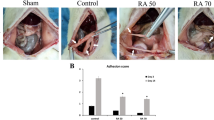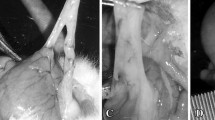Abstract
Postoperative peritoneal adhesions are common, serious complications of general abdominal and gynecologic surgery that can lead to chronic abdominal pain, intestinal obstruction, and infertility. As yet, there are no ideal drugs that may be prescribed for patients to prevent adhesion formation effectively. In this study the effects of escin, a natural drug, on the various steps of adhesion formation were investigated. The effects of escin on increased vascular permeability induced by acetic acid in a mouse model of acute inflammation, granuloma formation in a subchronic inflammatory rat model, gastrointestinal transit in rats with intestinal paralysis, intestinal motility in postoperative patients, and postoperative adhesion formation in a rat model were observed. It was shown that escin could inhibit acute inflammation and granuloma formation, cause acceleration of gastrointestinal transit, help recover intestinal motility, and attenuate the formation of postoperative adhesions. The findings suggest that escin attenuates the formation of postoperative adhesions by inhibiting inflammation and promoting gastrointestinal transit. Thus it may be concluded that both inhibition of inflammation and increased gastrointestinal motility during the early postoperative period have a positive effect on decreasing the formation of adhesions.

Similar content being viewed by others
References
Menzies D, Ellis H. Intestinal obstruction from adhesions: how big is the problem? Ann R Coll Surg Engl 1990;72:60–63
Menzies D. Prospective adhesions: their treatment and relevance in clinical practice. Ann R Coll Surg Engl 1993;75:147–153
Aldemir M, Ozturk H, Erten C, et al. The preventive effect of rofecoxib in postoperative intraperitoneal adhesions. Acta Chir Belg 2004;104:97–100
Guvenal T, Cetin A, Ozdemir H, et al. Prevention of postoperative adhesion formation in rat uterine horn model by nimesulide: a selective COX-2 inhibitor. Hum Reprod 2001;16:1732–1735
LeGrand EK, Rodgers KE, Girgis W, et al. Efficacy of tolmetin sodium for adhesion prevention in rabbit and rat models. J Surg Res 1994;56:67–71
Sirtori CR. Aescin: pharmacology, pharmacokinetics and therapeutic profile. Pharmacol Res 2001;44:183–193
Matsuda H, Li Y, Yoshikawa M. Possible involvement of dopamine and dopamine2 receptors in the inhibitions of gastric emptying by escin Ib in mice. Life Sci 2000;67:2921–2927
Matsuda H, Li Y, Yoshikawa M. Roles of endogenous prostaglandins and nitric oxide in inhibitions of gastric emptying and accelerations of gastrointestinal transit by escins Ia, Ib, IIa, and IIb in mice. Life Sci 2000;66:PL41–PL46
Matsuda H, Li Y, Yoshikawa M. Effects of escins Ia, Ib, IIa, and IIb from horse chestnuts on gastrointestinal transit and ileus in mice. Bioorg Med Chem 1999;7:1737–1741
Matsuda H, Li Y, Yoshikawa M. Possible involvement of 5-HT and 5-HT2 receptors in acceleration of gastrointestinal transit by escin Ib in mice. Life Sci 2000;66:2233–2238
Olajide OA, Awe SO, Makinde JM, et al. Studies on the anti-inflammatory, antipyretic and analgesic properties of Alstonia boonei stem bark. J Ethnopharmacol 2000;71:179–186
Ismail TS, Gopalakrishnan S, Begum VH, et al. Anti-inflammatory activity of Salacia oblonga Wall and Azima tetracantha Lam. J Ethnopharmacol 1997;56:145–152
Li ZH, Fu FH, Li XH, et al. The anti-inflammatory and analgesic effects of diclofenac sodium liniment. Chin Pharm J 1996;33:525–527
Ar’Rajab A, Ahren B, Rozga J, et al. Phosphatidylcholine prevents postoperative peritoneal adhesions: an experimental study in the rat. J Surg Res 1991;50:212–215
Cetin M, Duran B, Demirkoprulu N, et al. Effects of diazeniumdiolates (NONOates) and methylene blue on the reduction of postoperative adhesion in rats. Gynecol Obstet Invest 2004;57:186–190
Hellebrekers BW, Trimbos-Kemper TC, Trimbos JB, et al. Use of fibrinolytic agents in the prevention of postoperative adhesion formation. Fertil Steril 2000;74:203–212
Oncel M, Kurt N, Remzi FH, et al. The effectiveness of systemic antibiotics in preventing postoperative, intraabdominal adhesions in an animal model. J Surg Res 2001;101:52–55
Okamoto Y, Takai S, Yamada M, et al. Chymase inhibitors may prevent postoperative adhesion formation. Fertil Steril 2002;77:1044–1048
Cubukcu A, Alponat A, Gonullu NN, et al. An experimental study evaluating the effect of mitomycin C on the prevention of postoperative intraabdominal adhesions. J Surg Res 2001;96:163–166
Snoj M, Ar’Rajab A, Ahren B, et al. Effect of phosphatidylcholine on postoperative adhesions after small bowel anastomosis in the rat. Br J Surg 1992;79:427–429
Kutlay J, Ozer Y, Isik B, et al. Comparative effectiveness of several agents for preventing postoperative adhesions. World J Surg 2004;28:662–665
Holtz G. Prevention of postoperative adhesions. J Reprod Med 1980;24:141–146
Pijlman BM, Dorr PJ, Brommer EJ, et al. Prevention of adhesions. Eur J Obstet Gynecol Reprod Biol 1994;53:155–163
Down RH, Whitehead R, Watts JM. Why do surgical packs cause peritoneal adhesions? Aust N Z J Surg 1980;50:83–85
Eggleston RB, Mueller PO. Prevention and treatment of gastrointestinal adhesions. Vet Clin North Am Equine Pract 2003;19:741–763
Springall RG, Spitz L. The prevention of post-operative adhesions using a gastrointestinal prokinetic agent. J Pediatr Surg 1989;24:530–533
Sparnon AL, Spitz L. Pharmacological manipulation of postoperative intestinal adhesions. Aust N Z J Surg 1989;59:725–729
Garcia-Olmo D, Paya J, Lucas FJ, et al. The effects of the pharmacological manipulation of postoperative intestinal motility on colonic anastomoses: an experimental study in a rat model. Int J Colorectal Dis 1997;12:73–77
Saba AA, Godziachvili V, Mavani AK, et al. Serum levels of interleukin 1 and tumor necrosis factor alpha correlate with peritoneal adhesion grades in humans after major abdominal surgery. Am Surg 1998;64:734–736
Saba AA, Kaidi AA, Godziachvili V, et al. Effects of interleukin-6 and its neutralizing antibodies on peritoneal adhesion formation and wound healing. Am Surg 1996;62:569–572
Chegini N. Peritoneal molecular environment, adhesion formation and clinical implication. Front Biosci 2002;7:e91–e115
Roy S, Clark CJ, Mohebali K, et al. Reactive oxygen species and EGR-1 gene expression in surgical postoperative peritoneal adhesions. World J Surg 2004;28:316–320
Elkins TE, Warren J, Portz D, et al. Oxygen free radicals and pelvic adhesion formation. II. The interaction of oxygen free radicals and adhesion-preventing solutions. Int J Fertil 1991;36:231–237
Guillaume M, Padioleau F. Veinotonic effect, vascular protection, antiinflammatory and free radical scavenging properties of horse chestnut extract. Arzneimittelforschung 1994;44:25–35
Bougelet C, Roland IH, Ninane N, et al. Effect of aescine on hypoxia-induced neutrophil adherence to umbilical vein endothelium. Eur J Pharmacol 1998;345:89–95
Author information
Authors and Affiliations
Corresponding author
Rights and permissions
About this article
Cite this article
Fu, F., Hou, Y., Jiang, W. et al. Escin: Inhibiting Inflammation and Promoting Gastrointestinal Transit to Attenuate Formation of Postoperative Adhesions. World J. Surg. 29, 1614–1620 (2005). https://doi.org/10.1007/s00268-005-7870-5
Published:
Issue Date:
DOI: https://doi.org/10.1007/s00268-005-7870-5




